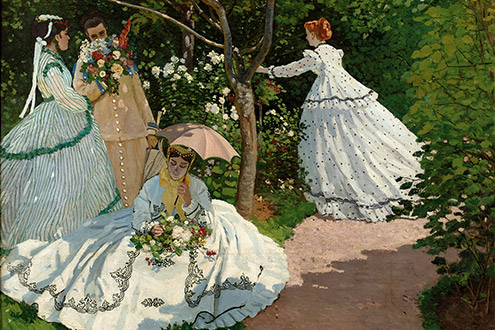“Impressionism, Fashion, and Modernity,” which was organized by the Musée d’Orsay, the Met, and the Art Institute of Chicago, has been at the Met for a while and will close on May 27. I finally got around to seeing it this past weekend and it’s a pretty stunning exhibition. Although everyone knows that life was much more formal in the 19th century for the upper classes, it is still remarkable to see these elaborate “day dresses,” with their gorgeous fabrics, bows, and tight waists, and imagine spending an ordinary day in one of them. The dresses are placed in rooms where they resonate with the paintings, and in one case, the dress on display is actually the one that is worn in the work of art, in Bartholomé‘s “The Woman in the Conservatory (Madame Bartholomé).” Men’s top hats and frock coats are on view as well, but, frankly, they make rather a poor showing when compared to the variety of the women’s wear.
But men’s accessories do appear in some of these paintings as highly-charged signifiers. Women’s dress can be a coded language for seduction, and in some of these paintings the women’s mussed or relaxed clothing, especially paired with men’s items lying casually around, indicates that they have been receiving male visitors. In Gustave Courbet‘s “Young Ladies on the Banks of the Seine (Summer),” the two women’s languid expressions and exposed petticoats, not to mention the top hat sitting casually in a boat nearby, let us know just what they have been up to on the grass. The painting shocked moral-minded visitors to the Salon of 1857. Manet‘s astounding “Young Lady of 1866” flaunts its timeliness in its title, just as the young lady in question flaunts her nosegay of violets and the man’s monocle around her neck as signs of the recent conquest of a lover. She looks at the viewer boldly and flirtatiously in a white dressing gown that also evokes intimacy and transparency.
Novelist Emile Zola is quoted often in the show, which makes sense, since he wrote about art, chronicled Paris’s first department store, obsessively observed women’s fashions, and wrote extremely cogent fictional treatments of social class. In one of his best novels, “La Curée” (translated as “The Kill;” the French word refers to the moment when hunting dogs can seize their portion of the dead animal, and figuratively means a scramble or mad rush), Zola details the extravagant and mesmerizing gowns worn by Renée, the heroine, which, along with real estate speculation, are symbols of the excess and decadence of the Second Empire.
“Impressionism, Fashion, and Modernity” will travel to the Art Institute of Chicago, where it will be on view from June 26 to September 22.
Image: Detail of Monet’s “Women in the Garden” (1866), courtesy Metropolitan Museum of Art.

